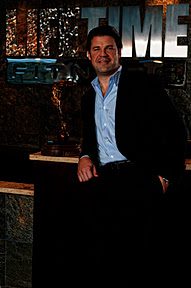At Life Time Fitness, physical fitness isn’t just the company’s line of business. It’s part of its approach to employee development too.
There’s a direct correlation between a healthy body and the mental capacity to learn and retain knowledge, said Jess Elmquist, senior vice president of Life Time University (LTU) and of recruiting and casting.
“I could be the best instructor in the world but if I have people who are undernourished and not fit, it doesn’t make a difference,” he said.
Physical fitness is interwoven into many aspects of life at the company, from recruiting to instructor-led training that includes workouts to corporate leadership that creates the expectation and example for healthy living through their own participation in yoga, Pilates and fitness boot camps.
The benefits of being in good physical shape have little do with winning a race, said Fred Harburg, a business consultant and former CLO at Motorola and Fidelity Investments. Those benefits are cognitive and emotional and produce higher energy, focus, problem-solving ability, sound judgment and reasoning and emotional well-being.
“For better or worse we are physical animals housed in human bodies,” he said. “When we ignore our bodies we are very much ignoring business and inevitably compromising results.”
Elmquist, an avid mountain biker who competes in several races a year, takes that idea to heart in his work at Life Time. The Minneapolis-based company has been rapidly growing by expanding from fitness clubs into new lines of business, including events, medical clinics and spas, with the aim of becoming what Elmquist called a “healthy way of living company.”
As Life Time grows into a projected $1 billion company this year, it’s important that mission of living healthy is part of every employee’s life, whether it’s at work or at home.
“We have the ability to empower an individual to be better,” Elmquist said. “They have learned skills, tactics and new abilities that they will be able to put into play in their job and in their personal life. We’ve helped them become better people.”
Physical Education
Elmquist joined Life Time in 1997 after a six-year stint as a high school economics and American history teacher. Intrigued by the business world, he took the leap after meeting Life Time founder and CEO Bahram Akradi. At the time, Life Time was a $19-million regional company with about 800 employees in Minneapolis.
“In those days, we did everything. We were involved in marketing and sales and new club development and openings,” Elmquist said. “I was able to very early on in my business career find out that I not only had an acumen for business but I had an acumen across the whole business sector based on the fact that we did so much as a small upstart company.”
Elmquist built the company’s business-to-business sales and marketing team from three employees to 17, eventually taking on the role of vice president of sales and marketing. He also kept teaching, leading training on topics such as sexual harassment as well as inspiration and leadership courses.
“Helping the company build from the beginning really helped me to touch and learn many parts of the business so that when my formal education and my learning expertise and business acumen matured together it was a really obvious fit for our organization to move me into the learning space,” he said.
Elmquist took the helm of Life Time University seven years ago after the company went public. At a meeting with Akradi and Life Time head of operations Jeff Zwiefel, Elmquist charted the path ahead and laid the groundwork for the employee infrastructure that has led to double-digit growth. In 2011, Life Time Fitness had more than 20,000 employees in 25 U.S. states and will soon open its first international location in Canada.
“As we sat down and talked about where LTU needed to go and how it needed to mature, the core philosophy that I brought to the table was that LTU had to create a learning culture. We feel it’s incredibly important in our culture that no one starts in a position until they have an opportunity to move into a learning space,” Elmquist said.
That meant not just developing training, but orchestrating a development experience and environment integrating instructors, curriculum and assessments to ensure employees develop the competency they need to fill a role. The end result is that employees “have the ability to go out and do that job from day one to make sure that the mission and the vision of Life Time Fitness is fulfilled,” Elmquist said.
The role of learning and development in that mission is critical, said John Reilly, Life Time senior vice president in charge of operations of the company’s in-club cafes and spas.
“We’re in the service business and the key differentiator is the people we have to bring that experience to life,” he said. “L&D is about making sure we have the right people in place. It’s at the heart of it from my perspective.”
Pumping Up Learning
To carry out that mission, LTU developed learning curricula and certification programs for all 20,000 staff members, from part-time employees, full-time supervisors, managers, department heads, general managers and area directors on up to regional vice presidents and senior executives. According to Elmquist, 100 percent of employees have been certified for their jobs five years running.
“The certification is to assess in a very fair and dynamic way that this person has the competency to actually fulfill the role,” Elmquist said. “If you don’t pass, you don’t move on.”
All that ongoing assessment, certification and development requires a robust L&D team. LTU employs 200 full- and part-time learning professionals who lead in-person sessions at headquarters as well as in regional facilities, supplemented with online learning hosted and managed through the LMS that allows employees to complete pre- and post-work virtually.
The distributed learning model promotes innovation while also ensuring maintenance of basic standards. “This allows our training organization to quadruple in size while holding to the mission and vision of the company,” Elmquist said.
Despite the cost, Life Time also still brings some groups, such as general managers, area directors and department heads in roles like personal training, sales and operations, to the Minneapolis headquarters for in-depth instruction, but also so they better understand the company’s mission and brand, Elmquist said. LTU also builds and maintains more than 90 percent of content in house so they’re better able to align with business needs.
“My team in LTU has to think like owners while supporting the operations of our business,” Elmquist said. “We win when they win and lose if they lose. We take every metric of the business seriously and believe we can impact each one through training and certification.”
In addition to running Life Time’s learning and development operations, Elmquist and his team also are responsible for recruiting and talent acquisition. The integration of acquisition with development begins with selecting and hiring based on specific standards around personal traits and work experience that are assessed through the interview process.
“Without the right hire with the right attitude and passion the following work to reinforce and recommit people to the mission and passion of Life Time is very hard to achieve,” Elmquist said. “Always in our hiring practice, in training and in leadership development we are constantly reminding and supporting our team members to define and understand why they do their jobs. Connecting the how and why is the critical element.”
To make that mission clear, LTU developed several training sessions employees attend throughout their career, including a history of Life Time and its mission called “Experience Life Time,” as well as customer service courses and training like “Questions that Matter Most” and “The Life Time Way.” Elmquist said training is reinforced by department heads and managers who have tools they can use to teach and lead by example.
The ability to connect the company’s mission to day-to-day operations is one of Elmquist’s strengths, Reilly said. “He’s an extremely dynamic presenter and facilitator. I love it when I get a chance for him to lead our training. He comes to life on the stage and connects relatively complex strategic concepts and boils them down to simple nuggets.”
A Fitness and Business Regimen
Like any good fitness coach, LTU tracks key statistics to mark progress and identify areas for improvement. In LTU’s case, those metrics include employee retention rates and individual employee growth and productivity, including how quickly a new team member gets up to speed in addition to rates of certification. It also tracks and measures against the company’s net promoter score, a measure of customers’ willingness to recommend Life Time to others.
Reilly said Elmquist and the LTU team are hard-wired into the company’s key performance indicators and continually assess and evaluate performance before and after training.
“Life Time is a performance-based culture,” he said. “We’re in the education business to ensure we deliver an experience that keeps our customers coming back. Training is always linked to specific, measurable business outcomes.”
Reilly saw that focus firsthand when he worked with Elmquist to launch two new lines of business, an in-house chiropractic clinic called LifeClinic and MediSpa, offering personal care services including hair removal and skin care.
Working on what Reilly called the “fuzzy front-end,” Elmquist and the LTU team drew up standard operating procedures, wrote job descriptions and interview guides, helped hiring managers with recruiting and integrated the new procedures into front-line training.
“With Jess’s help, we got it from an idea to something that is documented and we can train to,” Reilly said. Since piloting the two new services, Life Time has since opened 14 LifeClinics and 21 MediSpas with plans to have 50 of both services within the next two years.
That kind of focus on business and growth is critical for learning executives. Learning and development professionals have to be aggressive in pushing their message to the organization and making the connection to the organization’s strategic levers. Now is not the time to be a bashful CLO.
“Your senior executive management team has to value the learning culture. Our CEO, CFO and COO absolutely believe that LTU makes a difference every single day in every single thing we do,” Elmquist said.
“We roll our sleeves up and dive headlong into operations so that we become experts in each of those categories,” he said. “When that starts to happen, people start to notice and you get brought into the conversations.”
A healthy business led by healthy people is increasingly the difference maker for modern learning executives.
“If CLOs fail to include a more integrated model of human and organizational development in their learning agenda, they will be falling behind the companies that have the foresight to see it and embrace it,” said Harburg. “The increasing demands and volatility of our age make the ability to fully engage people with greater energy and resilience the imperative of the day.”
Life Time continues to grow aggressively from a regional health club operator in the upper Midwest into a multi-faceted health company with locations in 25 states, and growing healthy leaders is a core plank of its fitness regimen.
“Continuing to grow our future leaders is critical for us. It is a part of our core strategy going forward. We spend a lot of time on it,” Reilly said. “Under Jess’ leadership, I’m bullish that we’ll be ready for the challenge ahead.”
Mike Prokopeak is editorial director of Chief Learning Officer magazine. He can be reached at mikep@CLOmedia.com.















